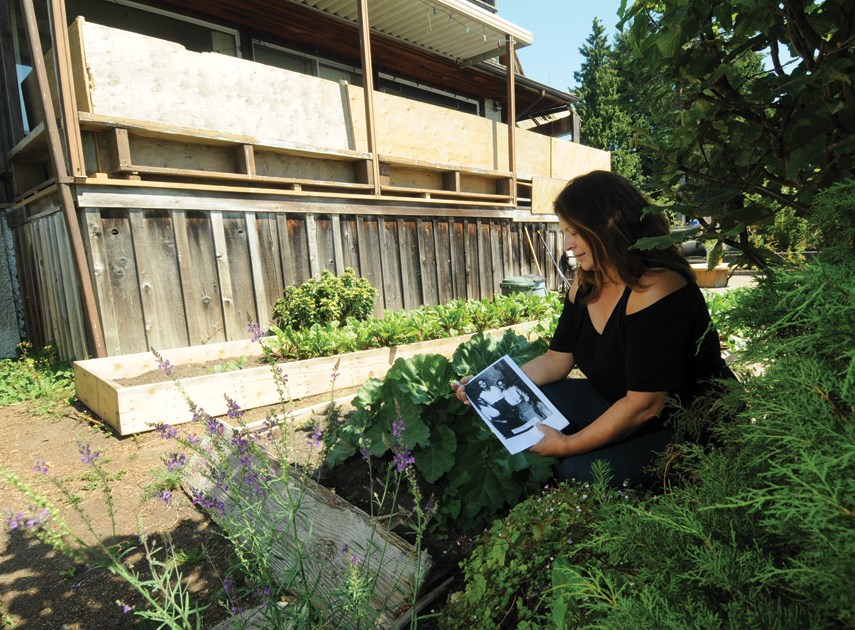This article has been revised.
When it comes to the Navvy Jack house, it’s time for nature to take its course.
That’s the verdict of Evelyn Lamont, the great, great granddaughter of the home’s original owner, West Vancouver pioneer Navvy Jack Thomas.
The District of West Vancouver is currently conducting an online survey to gauge the public’s appetite for a nature house at 1768 Argyle Ave., a prospect that would please Lamont.
“I would like them to keep the house as close as possible to the way it originally was,” she said.
Lamont has been rummaging through West Vancouver’s archives and comparing written records with the stories she heard about Thomas growing up.
Born in Wales, Thomas left Europe for Canada at 18 following a bitter dispute with his mother.
“She apparently had pushed him down the stairs,” Lamont said. “He never spoke to her again.”
Despite poring over personal correspondence – including the mother’s rejected request for her grandchildren to be educated in England – Lamont never uncovered the source of that dispute.
Thomas, who Lamont described as, “heavily built, square shouldered,” arrived in B.C. in 1859, chasing after gold in the Cariboo. In 1866, he ran sporadic ferry service between Vancouver and the land west of the Capilano River.
Thomas’ ferry was a small skiff with a rooster perched on the bow whose crow could be heard through the fog, Lamont said.
The venture didn’t last long.
“Everything he tried to get going, somebody else took away from him,” Lamont said.
Thomas’s greatest business success came in the gravel business.
Thomas dredged grit from the mouth of the Capilano River and shipped it to Vancouver, returning to West Vancouver and dropping anchor at Swy-Wee Lagoon, which is a duck pond today.
“He was hauling out gravel which the base of Vancouver city has been built on,” Lamont said.
Thomas made a “direct contribution to the construction of the built environment,” according West Vancouver’s statement of significance.
With business booming at neighbouring mills, Thomas’ gravel trade thrived, allowing him to buy 160 acres.
Using old growth fir and cedar, Thomas built what would be known as the Navvy Jack house around 1873.
The house was likely built for Rowia, the granddaughter of Chief Kiepilano.
Rowia and Thomas married, raising four children and living together in the home until Rowia’s death.
Thomas struggled to maintain his gravel business as the century drew to a close.
“He was in financial trouble because the guy that bought the other sloop was outbidding him on his gravel,” Lamont explained.
Thomas died searching for gold in Barkerville in 1897.
The home’s next owner was John Lawson, a future West Vancouver mayor who donated the land that would take council meetings out of a tent and into the community’s first municipal hall. Lawson planted holly near the Navvy Jack house. While the trees didn’t survive, the holly lives on in its namesake Hollyburn.
The Navvy Jack house would become the longest continuously occupied home in the Lower Mainland. Lloyd Williams, who moved into the home in 1971, would be the home’s final occupant.
There’s a connection between the home’s first and last residents, as Thomas’ son once saved Williams’ uncle from drowning in the Capilano River, according to West Vancouver’s statement of significance.
Writing in 2013, Williams extolled the idea of converting the home into a nature centre.
“It would be a gathering point for all ages to gain insight and information about the natural environment so special throughout our community,” he wrote in 2013. “It warms my heart that the district will be retaining the historic designation of Navvy Jack house.”
West Vancouver’s survey posits the house could be restored to its 1909 appearance for a cost of approximately $2.228 million. Other options include building a replica, which carries a $2.314 million price tag, or erecting a $1.3-million purpose-built nature centre with a plaque acknowledging the site’s heritage value.
The annual operating cost of the centre is projected to be $110,000.
A staff report is expected to be put before council this fall.
The survey is open until Sept. 30 at westvancouverite.ca/navvy.
An early version of this story listed the wrong year of Thomas' death. Records show he died in 1897.



